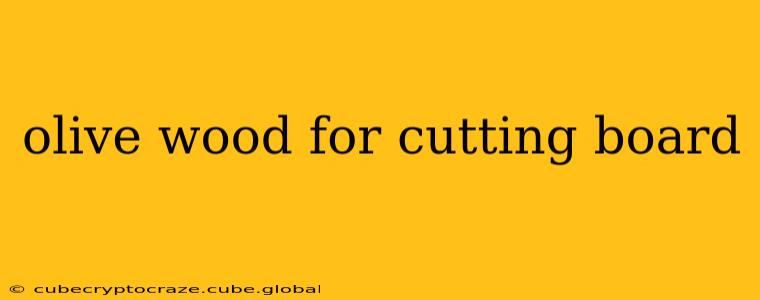Olive wood cutting boards are prized for their beauty, durability, and unique character. The rich grain, warm tones, and naturally antimicrobial properties make them a favorite among chefs and home cooks alike. But choosing the right olive wood cutting board, caring for it properly, and understanding its limitations are key to enjoying this stunning and functional kitchen staple. This comprehensive guide will answer all your questions about using olive wood for cutting boards.
What Makes Olive Wood Cutting Boards Special?
Olive wood's popularity stems from several key attributes:
- Stunning Aesthetics: The intricate grain patterns and rich, warm colors of olive wood make each cutting board a unique work of art. The variations in color and grain create a beautiful and visually appealing surface.
- Exceptional Durability: Olive wood is incredibly dense and hard, making it resistant to wear and tear. With proper care, an olive wood cutting board can last for generations.
- Natural Antimicrobial Properties: Olive wood contains natural oils and compounds that inhibit the growth of bacteria, making it a hygienic choice for food preparation. This doesn't mean you can skip regular cleaning, but it does offer an extra layer of protection.
- Self-Healing Properties: Minor surface scratches and knife marks tend to fill in over time due to the wood's density and oil content. This self-healing capability helps maintain the board's smooth surface and extends its lifespan.
Is Olive Wood Good for Cutting Boards? What are the Pros and Cons?
Pros:
- Beautiful and unique: Each board has its own distinctive grain pattern.
- Durable and long-lasting: With proper care, they can last a lifetime.
- Naturally antimicrobial: Helps prevent bacterial growth.
- Self-healing: Minor cuts and scratches often disappear over time.
- Feels great to work with: The warm, smooth texture is pleasant to the touch.
Cons:
- More expensive than other wood types: Olive wood is a premium material.
- Requires more careful maintenance: Proper oiling and care are essential.
- Can be porous: While less porous than some woods, it can still absorb liquids if not properly cared for. This necessitates thorough drying after washing.
- Not dishwasher safe: Hand washing is crucial to preserve the wood.
- Susceptible to cracking: Extreme temperature changes can cause cracking.
How to Choose an Olive Wood Cutting Board?
Consider these factors when selecting your olive wood cutting board:
- Size: Choose a size appropriate for your needs and available counter space.
- Thickness: Thicker boards are more durable and less prone to warping.
- Shape and Style: From rectangular to round, the options are diverse; choose one that complements your kitchen aesthetic.
- Construction: Look for boards made from a single piece of olive wood for optimal durability. Avoid boards with glued-together pieces, which are more likely to separate over time.
How Do You Care for an Olive Wood Cutting Board?
Proper care is essential to maintaining the beauty and longevity of your olive wood cutting board:
- Hand Wash Only: Never put your olive wood cutting board in the dishwasher. The high heat and harsh detergents can damage the wood.
- Wash with warm, soapy water: Use a mild dish soap and a soft sponge or brush.
- Dry thoroughly: After washing, dry the board immediately and completely with a clean towel. Leave it to air dry in a well-ventilated area.
- Oil Regularly: Apply mineral oil or food-grade olive oil to the board every few weeks, or as needed, to maintain its moisture and prevent cracking. Rub the oil in thoroughly and let it absorb overnight.
- Avoid soaking: Soaking can damage the wood and make it more prone to warping.
- Protect from extreme temperatures: Don't leave the board near heat sources or in direct sunlight.
How Often Should You Oil an Olive Wood Cutting Board?
The frequency of oiling depends on how often you use the board and the climate. As a general rule, oiling every few weeks is recommended, but you may need to oil more frequently in dry climates or if you use the board daily. The wood will appear dull when it's time for more oil.
Can You Put an Olive Wood Cutting Board in the Dishwasher?
No, olive wood cutting boards should never be put in the dishwasher. The high heat and harsh detergents will damage the wood, causing it to crack, warp, and lose its beautiful finish.
Are Olive Wood Cutting Boards Safe?
Yes, olive wood cutting boards are generally considered safe for food preparation. Their natural antimicrobial properties help inhibit bacterial growth. However, proper cleaning and drying are still crucial to maintaining hygiene.
Where Can I Buy an Olive Wood Cutting Board?
Olive wood cutting boards are available from various retailers, including kitchenware stores, online marketplaces, and specialty wood shops.
By following these tips and taking proper care of your olive wood cutting board, you'll enjoy its beauty and functionality for many years to come. Its unique character and lasting durability make it a cherished addition to any kitchen.
